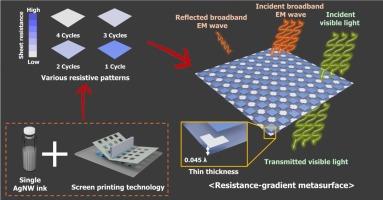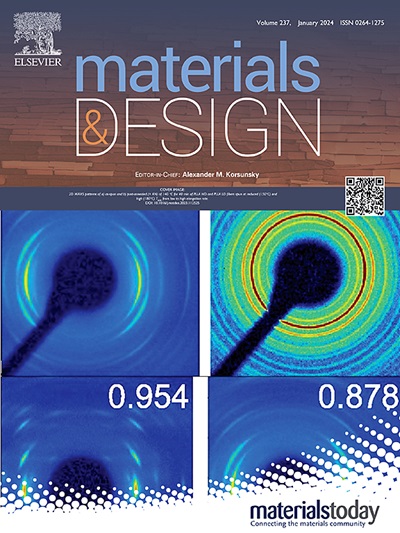仅使用单一银纳米线油墨就能丝网印刷出高/低电阻:用于宽带微波吸收和光学透明的电阻梯度元表面应用
IF 7.6
2区 材料科学
Q1 MATERIALS SCIENCE, MULTIDISCIPLINARY
引用次数: 0
摘要
透明超表面吸收器因其用途广泛而备受追捧,但在不牺牲光学透明度的前提下实现宽吸收带宽仍然是一项挑战。传统上,增强吸收能力需要增加基底厚度,这就会降低透射率。为了解决这个问题,我们引入了一种电阻梯度元表面 (RGM),它兼具宽吸收带宽和高光学透明度。与需要用不同油墨来产生不同电阻的传统方法不同,我们的方法使用单一银纳米线油墨和丝网印刷来产生多个电阻。这种技术可以在元表面内实现灵活的设计和多重共振,即使在基底很薄的情况下也能实现宽吸收。RGM 的吸收带宽从 8.68 GHz 到 11.48 GHz,基底厚度仅为 0.045 λ0,在 550 纳米波长处的光学透过率为 66.3%。这项创新有望提高透明超表面吸收器的衬底效率和带宽,扩大其在先进设备中的应用潜力。本文章由计算机程序翻译,如有差异,请以英文原文为准。

Screen-printing high/low resistance using only a single silver nanowire ink: Resistance-gradient metasurface application for broadband microwave absorption and optical transparency
Transparent metasurface absorbers are highly sought after for their diverse applications, but achieving broad absorption bandwidths without sacrificing optical transparency remains a challenge. Traditionally, enhancing absorption involves increasing substrate thickness, which reduces transmittance. We address this by introducing a resistance-gradient metasurface (RGM) that combines broad absorption with high optical transparency. Unlike conventional methods requiring various inks for different resistances, our approach uses a single silver nanowire ink and screen-printing to create multiple resistances. This technique allows for flexible design and multiple resonances within the metasurface, achieving broad absorption even with a thin substrate. The RGM demonstrates an absorption bandwidth from 8.68 to 11.48 GHz with a substrate thickness of just 0.045 λ0, and optical transmittance of 66.3 % at 550 nm. This innovation promises to enhance both substrate efficiency and bandwidth in transparent metasurface absorbers, broadening their application potential in advanced devices.
求助全文
通过发布文献求助,成功后即可免费获取论文全文。
去求助
来源期刊

Materials & Design
Engineering-Mechanical Engineering
CiteScore
14.30
自引率
7.10%
发文量
1028
审稿时长
85 days
期刊介绍:
Materials and Design is a multi-disciplinary journal that publishes original research reports, review articles, and express communications. The journal focuses on studying the structure and properties of inorganic and organic materials, advancements in synthesis, processing, characterization, and testing, the design of materials and engineering systems, and their applications in technology. It aims to bring together various aspects of materials science, engineering, physics, and chemistry.
The journal explores themes ranging from materials to design and aims to reveal the connections between natural and artificial materials, as well as experiment and modeling. Manuscripts submitted to Materials and Design should contain elements of discovery and surprise, as they often contribute new insights into the architecture and function of matter.
 求助内容:
求助内容: 应助结果提醒方式:
应助结果提醒方式:


